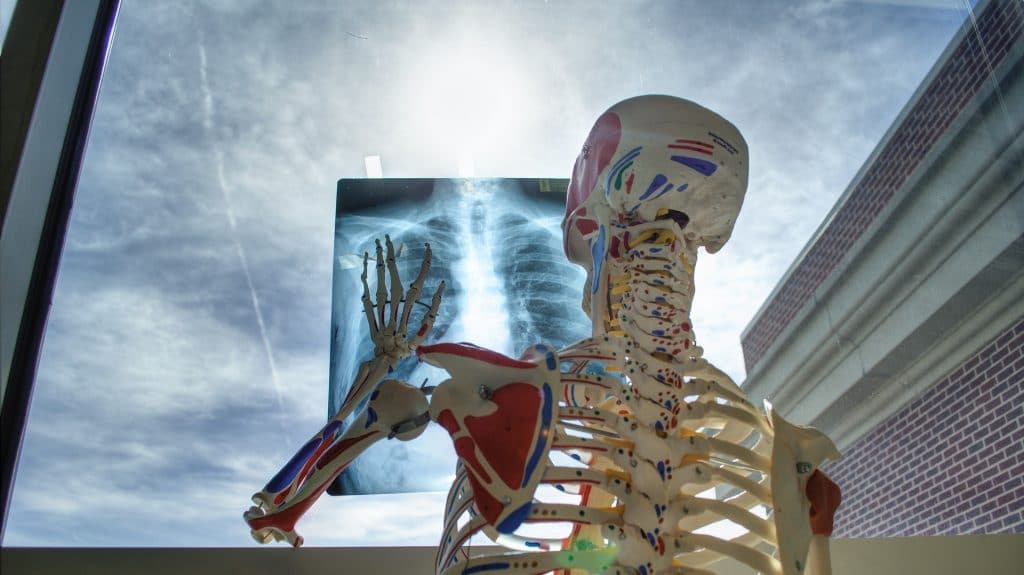Osteoporosis Treatment Q&A: All You Need to Know

Bone tissue is constantly broken down and rebuilt through two processes that run simultaneously. Osteoporosis is a condition that occurs when the balance between the two processes slightly shifts in favor of reducing bone mass, making bones more breakable.
Symptoms range from subtle such as back pain, loss of height, and stooped posture to dramatic—a sudden bone fracture after very little force is applied. Osteoporosis is a manageable condition, and there are two options for osteoporosis treatment—medications and lifestyle changes, which can be combined. In this article, we’ll answer the essential questions regarding the treatment of this condition.
Etiology of Osteoporosis
The word “osteoporosis” means “porous bone.” The condition can be viewed as being a part of the process of aging. Most people reach peak bone mass in their early 20s. When it comes to the causes of osteoporosis, aging is one of the significant factors. Namely, as we age, our bone tissue will start getting lost faster than it’s created. Some people are more likely to develop osteoporosis than others. In general, the higher the peak bone mass in your youth, the less likely you are to develop it.
Risk factors of osteoporosis include:
- Age—The older you are, the greater your risk.
- Sex—Women are much more susceptible to osteoporosis than are men.
- Race—Asians are most at risk when it comes to race.
- Family history—Having a family history of parents or siblings diagnosed with osteoporosis or easily suffering fractures increases your risk.
- Body type—People with small body frames have less bone mass to spare as they age.
- Hormones—Sex hormones protect bone mass, and the drop in estrogen levels after menopause is one of the strongest osteoporosis causes. An overactive thyroid, parathyroid, and adrenal glands are also risk factors.
- Medications—Particularly long-term steroid use, epilepsy, gastric reflux, transplant rejection drugs, and cancer increase your risk.
- Medical conditions—Gastrointestinal surgery, celiac disease, IBS, lupus, rheumatoid arthritis, multiple myeloma, cancer, liver, and kidney disease are known to speed up bone loss.
- Low calcium intake and eating disorders—Calcium deficiency and prolonged dietary restriction weaken bone tissue.
- Sedentary lifestyle, heavy alcohol consumption, and tobacco use.
What Is the Best and Safest Treatment for Osteoporosis?
Thanks to the currently available treatment options, people with osteoporosis don’t have to worry about performing normal daily activities independently. However, the first step toward treating osteoporosis is acceptance. Patients have to know that no pill will magically reverse the damage done by this disease.
The statistics worldwide show that osteoporosis is the cause of over nine million fractures a year. This means that one osteoporotic fracture happens every three seconds. However, if the proper prognosis of osteoporosis is made on time, you or your loved one could avoid these complications.
Due to a different hormonal background, women are more prone to developing osteoporosis. The National Osteoporosis Foundation suggests that women over 65 and men over 70 years should undergo a bone density test, as well as older adults who may have broken a bone after the age of 50.
It’s a painless test performed by a machine that uses moderate levels of X-rays to assess the proportion of minerals in your bones. During this test, you lie down while a scanner passes over your body. In most cases, the bones of the hip, wrist, and spine are checked.
Starting treatment is a step in the right direction for bone health. Nevertheless, you need to know which medication for osteoporosis is the best one for you and how long you’ll have to take it. Treatment recommendations for osteoporosis are based on an estimate of the chances of you breaking a bone in the next ten years based on the results from the bone density test.
If the risk is moderate to low, modifying risk factors for bone loss and falls can control it. Osteoporosis treatment guidelines recommend medication administration for patients who have a medium to high risk for bone fractures. Fortunately, osteoporosis can be treated, and its adverse effects reduced.
Let’s go over a few treatment options that seniors and their loved ones should know to take care of themselves in the face of this disease.
What Are the Treatment Options for Osteoporosis?
Regarding medications, there are several main groups, which are available by prescription only:
- bisphosphonates
- calcitonin drugs
- hormone therapy
- biologic drugs
However, the most commonly prescribed drugs to treat osteoporosis remain bisphosphonates. They work by inhibiting cells that break down bone (osteoclasts), allowing cells that build bone (osteoblasts) to correct the imbalance.
Hormone therapy is vital in osteoporosis prevention and treatment. However, the use of hormones doesn’t spare patients from the side effects either. Current recommendations suggest the minimum dose of hormones for the shortest period possible. Besides, women who have menopausal symptoms have to carefully consider using hormones, weighing the benefits of improved bone health.
Other related hormonal medications, such as hormone-like drugs (also known as selective estrogen receptor modulators), are also approved for the prevention and treatment of osteoporosis. Another member of the hormone therapy family is the recombinant protein of the parathyroid hormone. And it’s usually reserved for postmenopausal osteoporosis in women and men who meet the following criteria—possessing very low bone density or having already had a fracture.
Because it’s one of the causes, steroid medication may also call for using the recombinant parathyroid hormone. More importantly, the parathyroid hormone analogs have the potential to rebuild the bone. A comparatively newer player in osteoporosis treatment is the monoclonal antibody denosumab, considered a biologic therapy option.
It was proposed not only as an osteoporosis treatment, including treatment-induced bone loss but was also promised to affect bone metastases or a giant cell tumor of bone. It was also shown that denosumab reduced the risk of an osteoporotic fracture in both women and men. However, denosumab is the preferred drug for people who can’t take bisphosphonates, such as patients with reduced kidney function.
How Do Most Osteoporosis Medications Work?
Except for the recombinant parathyroid hormones, other medications can delay bone destruction. Usually, bones continuously break down and restore simultaneously. The two processes are at a steady-state in healthy bones. With aging, especially after menopause, the bones begin to break down faster.
Because bone recovery can’t catch up, bones deteriorate and become more prone to breaking. Here comes the role of osteoporosis drugs. They maintain the mutual process of destruction/rebuilding. Therefore, the primary function of these drugs is to effectively preserve bone density and decrease the risk of a fracture due to osteoporosis.
Best Treatment for Osteoporosis
The decision to prescribe one drug over another is based on both objective and subjective factors:
- The preferences of and convenience to the patients are taken into account.
- The ease of adhering to the dosing schedule plays a role.
- Osteoporosis medication can cost excessive amounts of money, especially for elderly people, regardless of whether the drug is a “preferred” option on their insurance company’s list of acceptable medications.
Keeping in mind the need for their long-term use, this can be a potential cause for medical bankruptcy. Regarding the dose regimen, your doctor might recommend a monthly dose of medication if it will be tolerated better. However, some people prefer to take their pills once a week instead of on a monthly schedule.
People with severe symptoms of osteoporosis and very low bone density, especially if they are younger, have had multiple fractures, and/or have used steroids, are more likely to be prescribed drugs different from bisphosphonates. Of course, these drugs can be used by any patient with osteoporosis.
In addition to the pill form of osteoporosis treatment, an injection is another option. Intravenous forms of bisphosphonates can also be a good choice for people who can’t tolerate an oral administration of bisphosphonate. As for more options for osteoporosis treatment, an infusion of drugs from the other therapy groups might also be given. And that’s to people who can’t tolerate oral bisphosphonates.
Common Side Effects of Osteoporosis Drugs
Since the bisphosphonate pills are not absorbed well in the stomach, their main adverse effects are heartburn and an upset stomach. It’s possible to avoid these potential side effects by taking the medication with a large glass of water before eating.
Then, avoid lying down or bending over for at least 60 minutes to keep the drug from washing back up into the esophagus. The rest of the osteoporosis treatment side effects should be neutralized by eating. However, a few people experience an upset stomach or heartburn even if they take their medicine correctly.
Infusion treatments for osteoporosis have some advantages over the pill form because there aren’t any gastrointestinal side effects. Moreover, it’s easier for some patients to schedule an infusion once or twice per year than to remember to take a pill every week or month. One of the severe drawbacks of infusion drugs for osteoporosis is mild flu-like symptoms in some people. However, this can be lessened if the patient takes an antipyretic medicine before the infusion.
Paradoxically, it’s been shown that long-term use of bisphosphonate has been linked to a rare medical condition of the femoral bone, meaning bisphosphonates can hurt your bones and even enhance some osteoporosis symptoms. The damage to the upper thigh bone, also known as an atypical femoral fracture, can begin to subtly but gradually get worse.
Another adverse effect of bisphosphonates, described rarely, is the osteonecrosis of the jaw, which can occur after tooth extraction. It typically only occurs with higher doses than what is standard for these common medications.
There’s some vagueness about how long one should take bisphosphonates because there aren’t any long-term studies. However, depending on the medications for osteoporosis, they have been shown as safe and effective for up to ten years of treatment. The good news is that even if you stop taking the medication, its positive effects can persist due to the accumulation of the drug in the bones.
Therefore, osteoporosis guidelines recommend that patients take a break from bisphosphonates after taking the treatment for five years. However, this is recommended only for patients who have not broken any bones and maintained bone density during the therapy.
Fracturing a Bone While on Osteoporosis Drugs
While you are on these medications, the chance of a fracture drops. However, osteoporosis drugs don’t eliminate the risk of breaking a bone entirely. If you have a fracture during the treatment, your doctor will look for contributing factors to the fractured bone. After the assessment, your therapeutic strategy can be switched to a more aggressive bone-building treatment.
Can Medication Alone Lead to Successful Osteoporosis Treatment?
The previously discussed drugs aren’t the only therapy for osteoporosis. The best treatment for osteoporosis also includes certain practices that help manage the disease:
- Preventing falls—Wearing low-heeled shoes with non-slip bottoms. It would help if you also made your home safe and secure. Check for electrical cords and slippery surfaces that might cause you to trip or fall. Keep rooms well lit, install grab bars inside and outside the shower door and bathtub, and use automatic flush toilets. Also, organize how you get into and out of bed comfortably. You may not need to take all of these precautions, but preparing ahead of time is always a good idea.
- Exercising—Physical activity with weights and specific osteoporosis exercises that promote balance and body posture can strengthen bones and lower the fracture risk. Staying active and fit lessens the chances of falling and breaking a bone. Exercises for osteoporosis of the spine have also shown to be quite effective.
- Maintaining optimal body weight—Being underweight puts you at risk of bone loss and fractures while being overweight also increases the chance of fractures occurring after falls.
- Proper nutrition—Eating a balanced diet and getting enough calcium and vitamin D in the form of a supplement can help you maintain healthy bones. Adequate protein intake is also crucial for maintaining bone elasticity.
- Limiting alcohol intake—If you drink alcohol, do so moderately (up to one drink a day).
- Quitting smoking—Smoking cigarettes enhances bone loss.
There are also osteoporosis natural treatment supplements. It was shown that soy protein might resemble the estrogen activity on bone tissue. Studies demonstrated that postmenopausal Asian women who consume tremendous amounts of soy protein have a lower chance of bone fracture. In fact, for more on this topic, read the osteoporosis treatment guidelines from 2020.
However, soy should be employed in diets cautiously for women with a family or personal history of breast cancer. Natural supplements can also help in osteoporosis prevention. It should be noted that most available soy products have failed to show a reduction of fracture risk. However, when some of the isoflavones found in soy are extracted in a laboratory setting and combined with calcium, it appears to prevent bone loss and diminish the pain linked to compression fractures in the spine.
Management of the Symptoms of Osteoporosis and COVID-19
A new global study has found that COVID-19 has a significant impact on the management of osteoporosis. The Fracture Risk Assessment Tool (FRAX) usage dropped by 58% in April 2020 alone. Moreover, according to estimations, over 500,000 osteoporosis patients have been excluded from risk assessment in three months, and many from the necessary osteoporosis treatment.
FRAX generates 10-year probabilities of fracture at the hip or major skeletal site by clinical risk factors, with or without bone material density (BMD) values. And their calculators are available in 66 countries, representing more than 80% of the worldwide population, and the tool is used by at least 228 countries globally.
So, the radical drop in FRAX usage increases the concern that COVID-19 is having a destructive impact on the management of this condition, with severe outcomes for the patients who can’t access timely testing and treatment.
Can I Reverse Osteoporosis Naturally?
Osteoporosis can’t be reversed. When we treat osteoporosis, we aim to keep any risk factors under control and prevent fractures from occurring by maintaining or improving bone density. Therefore, you can change the impact of osteoporosis by:
- being active
- getting enough calcium and vitamin D
- taking proper medication
Can You Rebuild Bone Density?
You can slow down bone loss, but you can’t reverse the changes. The quality of the new bone tissue is presumably excellent, but it’s not the same as before the disease. Depending on the status of your bones, you can restore some of your bone tissue and get out of the osteoporosis range with drug therapy.
What Vitamins Help Bone Density?
Most doctors think that vitamins help maintain healthy bones. Here are the two most important vitamins to include in your diet:
Vitamin D
Getting enough vitamin D is essential if you have osteoporosis. This is because vitamin D is in charge of helping the body absorb calcium and build strong bones. Even though it’s not usually present in many foods, there are still some foods with a good amount of vitamin D. Sun exposure makes your body produce vitamin D. Still, sometimes the seasons don’t permit your body to produce enough.
It’s recommended after an osteoporosis diagnosis that adults older than 50 take between 800 and 1,000 IU of vitamin D daily. Both vitamins D2 and D3 are prepared in supplement form. According to the US Preventive Services Task Force, for women who are 65 and older or at a heightened risk for falls, taking vitamin D supplements can effectively lead to the prevention of osteoporosis.
Vitamin K
Vitamin K helps calcium to adhere to your bones. However, it’s essential to maintain a balance between enough and too much vitamin K. The recommended dosage is 150 micrograms daily, which you can get from many foods containing vitamin K that should be a part of your diet.
However, researchers don’t all accept the benefits of taking vitamins and supplements, including calcium and vitamin D, for keeping most risk factors for osteoporosis under control. Others suggest that too much calcium could cause calcification of the arteries, contributing to heart disease. We should also note that if an osteoporosis patient has kidney or parathyroid disease, they may not be able to take vitamins or supplements due to an impaired ability to filter calcium, vitamin D, and other nutrients.
What Is the Best Exercise for Bone Density?
Exercising might be a source of worry for some with osteoporosis since it seems like it increases the risk of falling and breaking a bone. However, a regular and well-designed workout program may help prevent falls and fractures. That’s because exercising strengthens bones and muscles and improves balance, coordination, and flexibility. It’s never too late to start doing exercises for osteoporosis.
Before you start a new exercise routine, talk with your doctor and physical therapist about what’s safe for you based on your:
- stage of osteoporosis
- fitness level
- weight
There are numerous exercises for osteoporosis of the hip, spine, etc. The program for physical activity should be unique to every patient because it’s based on many factors, such as:
- fracture risk
- muscle strength
- range of motion
- fitness
- balance
The training may include weight–bearing exercises for osteoporosis, such as:
- brisk walking
- climbing stairs
- dancing
- hiking
- jogging
- jumping rope
- doing step aerobics
- playing tennis or other racquet sports
- doing yard work, like pushing a lawnmower or gardening
If you’re inexperienced with exercise or haven’t worked out for a while, you should aim to slowly increase the amount you do until you get to 30 minutes of weight-bearing exercise per day on most days of the week. This exercise directly impacts the osteoporosis pathophysiology.
The so-called non-impact exercises don’t directly strengthen your bones but improve coordination, flexibility, and muscle strength. This will decrease the chances of falling and breaking a bone. You can do these exercises every day. Other routines like yoga for osteoporosis and pilates can enhance strength, balance, and flexibility in people with osteoporosis. However, some of the moves in these programs should be avoided because they can make you more likely to get a fracture.
Exercise can benefit almost everyone with osteoporosis. But remember, it’s only a part of a good treatment plan along with an osteoporosis diet treatment and medications. The most important things to consider are improving strength and balance when engaging in exercise.
In addition to the exercises already discussed, balance exercises such as Tai Chi can stimulate your leg muscles and help you stay steadier on your feet, so they are also some of the best exercises for osteoporosis. Furthermore, posture exercises can help you handle the “sloping” shoulders related to osteoporosis and reduce the chances of spine fractures.
What Foods Improve Bone Density?
A good diet and high-quality magnesium supplements have the power to strengthen a weak skeleton. Higher consumption of the following foods can lead to greater bone mineral density.
- Seeds, nuts, milk, and leafy greens are the best foods for improving bone density.
- Foods rich in alpha-linolenic acid, an omega-3 fatty acid, can modify the rate of bone breakdown and bone formation. This includes walnuts, Brazil nuts, pumpkin seeds, flaxseed oil, ground flaxseeds, walnut oil, soybeans, soybean oil, and canola oil. Along with being one of the good osteoporosis treatment options, nuts and seeds are considered excellent magnesium sources.
- Fluoride, famed for its importance in tooth health, also contributes to bone density. Thus, drinking tap water aids in getting enough fluoride to protect your teeth and bones.
- Beans, salmon, and milk are good sources of magnesium, calcium, and vitamin D, so they should also be included if you want to achieve better results. Surprisingly, dairy products generally contain insufficient quantities of vitamin D.
- Drinking red wine benefits bone-building osteoblasts while inhibiting bone-resorbing osteoclasts and thus contributes to bone formation. Drinking beer also positively impacts bone strength.
Therefore, when it comes to osteoporosis, natural treatment might be grabbing a small handful of nuts for a snack or sprinkling a couple of tablespoons onto your oatmeal. Fresh salads and steamed green vegetables are packed with bone-building nutrients, particularly calcium, magnesium, and vitamin K. The latter is critical in forming bone proteins and cuts calcium loss in urine.
What Not to Eat if You Have Osteoporosis?
Surprisingly, your diet could be one of your risk factors. The Standard American Diet is acknowledged as “the perfect recipe for osteoporosis.”
- Refined sugars and carbohydrates have been shown to destroy bone by stimulating bone-removing osteoclasts.
- High blood sugar due to excessive sugar consumption is proven to boost urinary calcium excretion, just like phosphorus, leading to a weakening of the bones. Elevated blood glucose levels lead to the modification of blood proteins, inflammation, and a rise in the levels of triglycerides and LDL. Along with being osteoporosis risk factors, these circumstances enhance the risk of stroke or heart attack, type 2 diabetes, and diseases like Alzheimer’s and Parkinson’s.
- Excess phosphorus can also impact the removal of calcium from the bones, which is then lost through urine, that’s why an osteoporosis diet shouldn’t contain too much of it. Furthermore, the 2006 Framingham Osteoporosis study found that people who regularly consumed cola-based sodas (rich in phosphorus) had a 4% lower bone mineral density.
- Polyunsaturated omega-6 fatty acids, found in vegetable oils like soy, corn, sunflower, and canola, encourage inflammation that may contribute to bone loss, in contrast to their anti-inflammatory counterpart, omega-3 fatty acids.
- Excessive salt intake may aggravate the loss of calcium through urine. Assuming that this loss is from the bones, this equates to 1% bone loss each year.
What Is the Life Expectancy of a Person With Osteoporosis?
Despite reports that patients with osteoporosis have a heightened risk of dying prematurely, a new study has found that the life expectancy of osteoporosis patients diagnosed early and adequately treated can be extended by 15 years. This was observed in women below the age of 75 and men below the age of 60.
More detailed analyses reveal that the remaining life expectancy after beginning treatment for osteoporosis was estimated to be about 18 years for a 50-year-old man and 7.5 years for a 75-year old man. In contrast, for women, it was around 26 years and 13.5 years, respectively.
The study published in the Journal of Bone and Mineral Research showed that most patients undergoing treatment have a long life expectancy. Therefore, it’s vital to develop more evidence-based strategies to manage the long–term effects of osteoporosis.
Conclusion
It’s well-known that the bone structure deteriorates with age, but osteoporosis also weakens the outer cortex of long bones, causing spontaneous and surprising fractures. Among the many reasons to treat osteoporosis, preventing fractures and breaks is particularly important.
It’s crucial to remember that even though the bone loss is a severe condition, proper treatments for osteoporosis can diminish its unpleasant symptoms and reduce the risk of complications such as bone fractures. Proper treatment also can elevate your quality of life and, in turn, extend it.
FAQs
What causes osteoporosis?
Possible osteoporosis causes involve specific medical conditions, like hyperthyroidism. Also, the use of certain medications contributes to the development of this condition. As for the risk factors, they include:
- age
- menopause
- being female
- poor nutrition
- having a family history of osteoporosis
- being Caucasian or Asian
- physical inactivity
- smoking
- small-boned frame
- low body weight
What is the new drug for osteoporosis?
A new form of an osteoporosis drug provides a new option for patients, with the potential for fewer side effects. Purdue University innovators developed a stabilized form of human calcitonin—a peptide drug already used to treat osteoporosis.
What is the most popular treatment for osteoporosis?
Generally speaking, treatment options are often based on an estimate of your risk of breaking a bone in the following 10-year period, using data like the bone density test. That said, if there isn’t a high risk, treatment may focus on modifying risk factors for bone loss and falls rather than including medication.
And if it comes to medication, the most widely prescribed ones are bisphosphonates. Be that as it may, evolving evidence suggests that anabolic osteoporosis treatment as first-line therapy medication provides excellent benefits. And that’s some of the strongest data on the newer agents in the last ten years.
What is the best natural treatment for osteoporosis?
Many people turn to nutritional supplements as a treatment option. That said, some of them include:
- calcium
- vitamin D
- boron
- copper
- folic acid
- vitamin B6
- vitamin B12
- zinc
- horsetail
- red clover
- black cohosh
However, before taking any of them, talk to your doctor.
Is there any treatment for osteoporosis?
This condition affects people all over the world. And even though an osteoporosis cure doesn’t exist, treatments are available. They include medications, hormone therapy, and exercise. In fact, they can strengthen your bones and slow down bone loss. So, if you have osteoporosis, make sure you talk to your doctor to discuss possible osteoporosis treatment.






